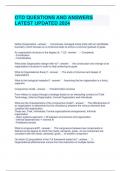Resume
Summary Multimodal freight transport and port management
- Établissement
- Katholieke Universiteit Leuven (KU Leuven)
This document is fully written in English. It is a complete summary of all powerpoints explanations given by the tutor in class. At the end you can find recaps of the chapters we had to read & discuss in class. - Also have a look at my profile for other summaries.
[Montrer plus]




